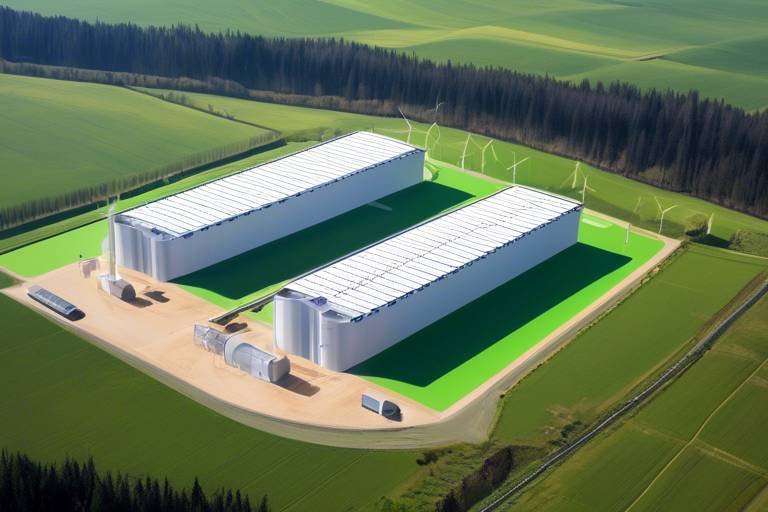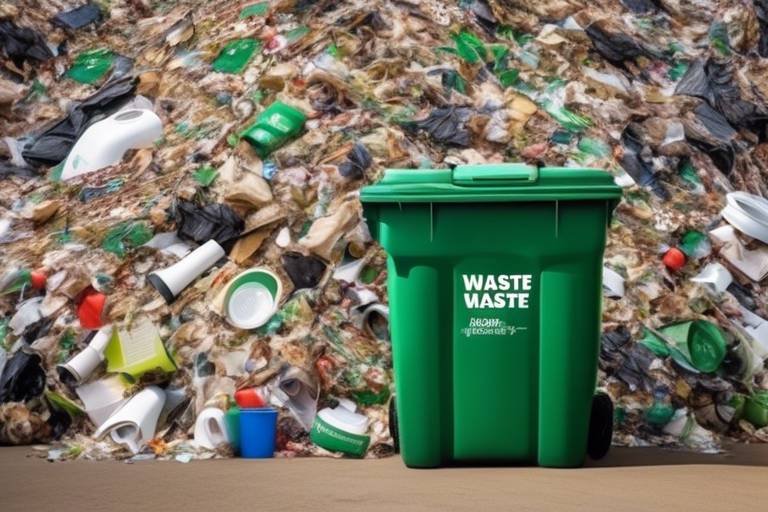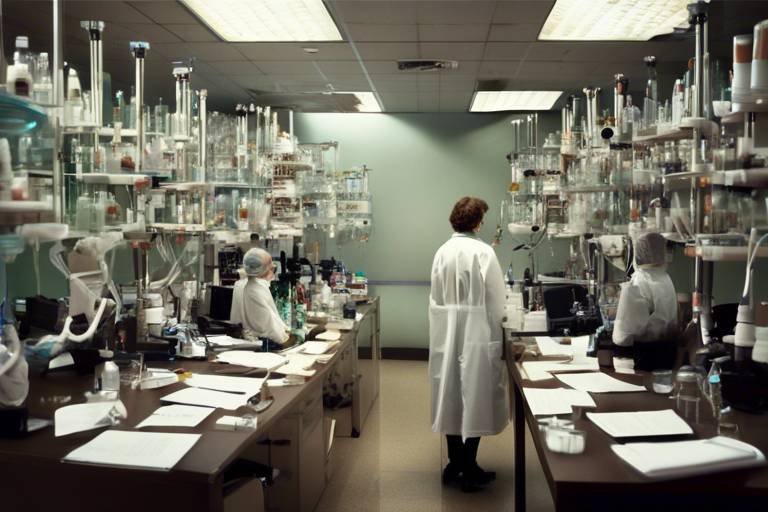The Impact of Science on Food Safety Regulations
In today's world, the intersection of science and food safety regulations is more critical than ever. With the increasing complexity of our food supply chains and the rising concerns about foodborne illnesses, scientific advancements have become a cornerstone in shaping the regulations that protect public health. But what exactly does this mean for consumers and producers alike? Well, it means that every bite we take is backed by rigorous research and innovative technology designed to keep us safe. As we delve deeper into this topic, we’ll explore how scientific research and technological innovations have not only enhanced food safety but also ensured the quality of the food we consume.
At the heart of food safety regulations lies scientific research. This research is crucial for developing evidence-based guidelines that help mitigate risks associated with foodborne illnesses. Think of it as a safety net that catches potential hazards before they can impact public health. For instance, studies on microbial pathogens have led to the establishment of maximum allowable limits for certain contaminants in food products. These limits are not arbitrary; they are grounded in extensive research that assesses the risks associated with various microorganisms.
Moreover, the role of scientific research extends beyond just identifying risks. It also involves evaluating the effectiveness of existing safety measures and suggesting improvements. This cycle of continuous improvement ensures that food safety regulations evolve in response to new findings and emerging threats. In essence, science acts as both a compass and a shield, guiding regulators and protecting consumers.
As we move forward, the landscape of food safety is being reshaped by technological innovations. Tools such as blockchain, artificial intelligence (AI), and advanced data analytics are revolutionizing how we track, monitor, and manage food products throughout the supply chain. Imagine being able to trace the origin of your food with just a scan of your smartphone. This level of transparency not only empowers consumers but also holds producers accountable for the safety of their products.
For example, blockchain technology allows for real-time tracking of food items, ensuring that any contamination can be swiftly identified and addressed. This rapid response capability is crucial in preventing widespread outbreaks of foodborne illnesses. Additionally, AI can analyze vast amounts of data to predict potential safety risks, enabling proactive measures rather than reactive ones. In a world where food safety is paramount, these innovations are game-changers.
One of the key components of food safety is microbial risk assessment. This scientific approach helps us understand the potential hazards present in food products. By evaluating the likelihood and consequences of microbial contamination, regulators can prioritize safety measures based on solid scientific data. It's akin to having a weather forecast for food safety—foreseeing potential storms and preparing accordingly.
Innovative pathogen detection methods have significantly improved our ability to identify harmful microorganisms in food quickly. Traditional methods often took days or even weeks, but modern techniques can yield results in just hours. This rapid identification is crucial in preventing outbreaks and ensuring consumer safety. Imagine a world where a potential outbreak can be contained before it even has a chance to spread—this is the power of advanced pathogen detection.
Quantitative risk assessment models provide a structured approach to evaluating food safety risks. These models use statistical analysis and scientific evidence to inform regulatory decisions. By quantifying risks, regulators can make informed choices that enhance food safety without stifling innovation. It's like having a roadmap that guides us through the complex terrain of food safety, ensuring we reach our destination—public health—safely.
The development of food safety standards is heavily influenced by scientific findings. These standards are not static; they evolve as new research emerges, ensuring they remain relevant and effective in protecting public health. The collaboration between scientists and regulators is vital in this process, as it helps bridge the gap between research and real-world application. In many ways, it’s a partnership aimed at safeguarding our food supply.
In an increasingly interconnected world, international collaboration in food safety regulations is essential. This is where science plays a pivotal role, driving the need for harmonized standards that address global food supply challenges. By sharing knowledge and research, countries can work together to tackle issues that transcend borders.
The Codex Alimentarius Commission is a prime example of this collaborative effort. It sets international food safety standards influenced by scientific research, ensuring that food products are safe and suitable for consumption across borders. This global framework helps countries align their regulations, making it easier to trade while maintaining high safety standards.
While global standards are crucial, regional regulatory frameworks adapt these standards to local contexts. They incorporate scientific insights to address specific food safety challenges faced by different populations. This localized approach ensures that regulations are not only effective but also culturally relevant, enhancing their overall impact on public health.
Looking ahead, emerging trends in food safety, driven by ongoing scientific research, will shape future regulations. These trends focus on sustainability, consumer preferences, and advanced technologies aimed at enhancing food safety practices. As we navigate this evolving landscape, it's clear that science will continue to be our guiding light, illuminating the path toward safer food for everyone.
- What is the role of science in food safety regulations? Science provides the evidence and guidelines necessary for developing effective food safety standards.
- How do technological innovations impact food safety? Technologies like blockchain and AI improve tracking and monitoring of food products, enhancing safety measures.
- What is microbial risk assessment? It's a method used to evaluate potential hazards in food products, guiding regulatory decisions.
- Why are global food safety regulations important? They ensure harmonized standards that protect public health and facilitate international trade.

Scientific Research and Food Safety
Scientific research plays a crucial role in developing food safety standards that are vital for protecting public health. Imagine walking into your favorite grocery store and picking up a product that has been rigorously tested and validated by the latest scientific findings. This isn't just a dream; it's the reality that modern science has made possible. By providing evidence-based guidelines, researchers help to mitigate risks associated with foodborne illnesses, which, as many of us know, can have serious health implications.
Every year, millions of people get sick from contaminated food, and this is where scientific research steps in as a formidable ally. Researchers conduct extensive studies to identify potential hazards in food products, ranging from microbial contamination to chemical residues. For instance, the identification of specific pathogens like Salmonella or E. coli has led to the development of targeted safety measures that keep these threats at bay. The findings from these studies are not just academic; they translate into actionable regulations that food manufacturers and suppliers must follow.
One of the most fascinating aspects of scientific research in food safety is the use of microbial risk assessment. This process involves evaluating the likelihood of foodborne illnesses occurring from specific pathogens. By analyzing data collected from various sources, researchers can prioritize safety measures based on the level of risk associated with different foods. For example, a recent study might highlight that leafy greens pose a higher risk of contamination than processed meats, prompting regulators to focus more on ensuring the safety of the former.
Furthermore, scientific research is not a one-time event; it is an ongoing process. As new technologies emerge and our understanding of food safety evolves, researchers continually update their findings. This dynamic nature of science ensures that food safety regulations remain relevant and effective. For instance, the rise of food delivery services and online grocery shopping has necessitated new research into how food safety practices can adapt to these changes in consumer behavior.
To summarize, the impact of scientific research on food safety is profound and multifaceted. It lays the groundwork for evidence-based regulations, enhances public health initiatives, and ultimately ensures that the food we consume is safe and of high quality. As we continue to advance in science and technology, we can expect even more innovative approaches to food safety that will keep us all healthier.
- What is the role of scientific research in food safety?
Scientific research helps develop evidence-based guidelines and standards that protect public health by identifying and mitigating foodborne risks.
- How does microbial risk assessment work?
This process evaluates the likelihood of foodborne illnesses from specific pathogens, helping prioritize safety measures based on risk levels.
- Why are food safety regulations updated regularly?
Food safety regulations are updated to reflect new scientific findings, technological advancements, and changes in consumer behavior to ensure ongoing protection.

Technological Innovations in Food Safety
The landscape of food safety is undergoing a remarkable transformation, thanks to technological innovations that are reshaping how we approach food quality and safety. With the rise of technologies like blockchain and artificial intelligence (AI), the food industry is not just keeping up with safety standards; it’s setting new ones. These advancements are not merely trends; they represent a fundamental shift in how food safety practices are implemented across the supply chain.
One of the most exciting developments is the use of blockchain technology. Imagine a world where every step your food takes from farm to table is documented in an immutable ledger. This technology provides transparency and traceability, allowing consumers and regulators to track food products at every stage. It’s like having a detailed map of your food’s journey, which can be invaluable during a food safety crisis. If a contamination issue arises, blockchain can quickly identify the source, helping to mitigate risks and protect public health more efficiently than ever before.
Moreover, AI and machine learning are revolutionizing how we analyze data related to food safety. These technologies can sift through vast amounts of information, identifying patterns and predicting potential risks before they become serious problems. For instance, AI can analyze historical data on foodborne illnesses to predict where outbreaks are likely to occur, allowing for proactive measures to be taken. This predictive capability is akin to having a crystal ball that informs food safety experts about potential threats, enabling them to act swiftly.
In addition to these innovations, smart sensors and IoT (Internet of Things) devices are playing a pivotal role in monitoring food safety in real-time. These devices can track temperature, humidity, and other critical factors that affect food quality. For example, if a shipment of perishable goods is exposed to temperatures outside the safe range, alerts can be triggered immediately, preventing spoilage and ensuring that only safe products reach consumers. This kind of real-time monitoring is like having a vigilant guardian watching over our food supply, ready to intervene when necessary.
As we delve deeper into the realm of food safety technology, we see the emergence of automated pathogen detection systems. These systems utilize advanced molecular techniques to identify harmful microorganisms in food samples with remarkable speed and accuracy. Traditional methods of pathogen detection can take days, but with these innovative systems, results can be obtained in just a few hours. This rapid response capability is crucial in preventing foodborne illness outbreaks, as it allows for immediate action to be taken when a threat is identified. It’s like having a superhero on standby, ready to swoop in and save the day.
As we look to the future, it’s clear that the integration of technology in food safety is not just beneficial but essential. The challenges of ensuring food safety are becoming increasingly complex, and technological innovations provide the tools needed to navigate these challenges effectively. By leveraging these advancements, the food industry can enhance its safety protocols, ultimately leading to safer food for consumers worldwide.
- How does blockchain improve food safety?
Blockchain enhances food safety by providing a transparent and traceable record of a food product's journey from farm to table, allowing for quick identification of contamination sources. - What role does AI play in food safety?
AI analyzes large datasets to predict food safety risks, allowing for proactive measures to be taken before problems arise. - What are smart sensors?
Smart sensors monitor conditions like temperature and humidity in real-time, ensuring that food products remain safe throughout the supply chain. - How fast can pathogen detection systems work?
Automated pathogen detection systems can provide results within hours, significantly faster than traditional methods that may take days.

Microbial Risk Assessment
Microbial risk assessment (MRA) is a critical process in the realm of food safety that serves as a cornerstone for making informed regulatory decisions. This scientific approach helps us understand the potential hazards posed by microorganisms in food products, enabling authorities to prioritize safety measures effectively. Think of it as a detective story, where scientists play the role of detectives, piecing together clues to identify the culprits behind foodborne illnesses. By analyzing data from various sources, they can determine how likely it is for a specific pathogen to cause harm, thus guiding the development of regulations that protect public health.
At its core, microbial risk assessment involves several key steps, including hazard identification, exposure assessment, dose-response assessment, and risk characterization. Each step builds upon the previous one, creating a comprehensive understanding of the risks involved. Here’s a quick breakdown:
- Hazard Identification: This step involves identifying which microorganisms are of concern. Are we talking about Salmonella, E. coli, or Listeria? Understanding the specific threats is crucial.
- Exposure Assessment: Here, scientists evaluate how much of the pathogen people are likely to encounter through food consumption. This includes looking at factors like food handling practices and cooking methods.
- Dose-Response Assessment: This phase assesses the relationship between the dose of the pathogen and the likelihood of adverse health effects. Essentially, it helps determine how much of a pathogen is needed to cause illness.
- Risk Characterization: Finally, all the gathered information is synthesized to provide a clear picture of the overall risk, helping regulators make informed decisions.
The significance of microbial risk assessment cannot be overstated. It allows regulatory bodies to allocate resources effectively and implement measures that can significantly reduce the incidence of foodborne illnesses. For instance, if a specific strain of bacteria is found to be particularly virulent, regulators can prioritize testing and monitoring of foods associated with that pathogen. This proactive approach not only safeguards public health but also builds consumer trust in the food supply.
Moreover, as our understanding of microbiology evolves, so too does the methodology behind microbial risk assessment. Advances in technology, such as genomic sequencing and bioinformatics, enable scientists to analyze microbial populations with unprecedented accuracy. This means that risk assessments can be more precise, leading to better-targeted regulations that adapt to the ever-changing landscape of food safety.
In conclusion, microbial risk assessment is not merely a bureaucratic exercise; it’s a vital process that integrates science, technology, and public health. By continuously refining these assessments and adapting to new scientific findings, we can ensure that our food safety regulations remain robust and effective in protecting consumers from the hidden dangers lurking in our food supply.
What is microbial risk assessment?
Microbial risk assessment is a scientific process used to evaluate the potential hazards posed by microorganisms in food products. It helps regulatory bodies make informed decisions to ensure food safety.
Why is microbial risk assessment important?
This assessment is crucial for identifying foodborne pathogens, understanding their risks, and implementing safety measures that protect public health.
What are the key steps in microbial risk assessment?
The main steps include hazard identification, exposure assessment, dose-response assessment, and risk characterization.
How does technology impact microbial risk assessment?
Advances in technology, like genomic sequencing, allow for more precise analysis of microbial populations, leading to better-targeted food safety regulations.

Pathogen Detection Methods
In the ever-evolving landscape of food safety, stand as a critical line of defense against foodborne illnesses. These methods are not just about identifying harmful microorganisms; they are about ensuring that the food we consume is safe and free from contaminants. Imagine walking into a grocery store and being assured that every product on the shelf has been rigorously tested for pathogens. This assurance is made possible by advanced detection techniques that have revolutionized food safety.
One of the most significant advancements in pathogen detection is the use of molecular techniques, such as Polymerase Chain Reaction (PCR). This method allows for the rapid amplification of DNA from pathogens, enabling detection in a matter of hours rather than days. The speed and accuracy of PCR have made it a go-to method in laboratories around the world. However, it’s not just PCR that’s making waves; other technologies, such as next-generation sequencing (NGS), are also gaining traction. NGS can identify multiple pathogens simultaneously, providing a comprehensive overview of potential threats in food products.
Another notable method is the use of immunological techniques, which utilize antibodies to detect specific pathogens. Enzyme-linked immunosorbent assay (ELISA) is one such technique that is widely used in food safety testing. It offers a reliable way to quantify pathogens in food samples, providing critical data to regulators and manufacturers alike. The combination of these methods enhances the capability of food safety laboratories to respond to potential outbreaks swiftly.
To illustrate the effectiveness of these methods, let’s take a look at a comparison of various pathogen detection techniques in terms of speed, sensitivity, and specificity:
| Detection Method | Speed | Sensitivity | Specificity |
|---|---|---|---|
| Polymerase Chain Reaction (PCR) | Hours | High | High |
| Next-Generation Sequencing (NGS) | Days | Very High | Very High |
| Enzyme-Linked Immunosorbent Assay (ELISA) | Hours | Moderate | High |
As we continue to innovate and refine these methods, the importance of rapid response cannot be overstated. In the event of a suspected outbreak, the quicker we can identify the pathogen, the faster we can take action to protect public health. This is where the integration of technology plays a vital role. For instance, the implementation of real-time monitoring systems equipped with pathogen detection capabilities can alert food producers and regulators instantly, enabling them to act before a minor issue becomes a widespread crisis.
In conclusion, the landscape of pathogen detection is constantly evolving, driven by scientific advancements and technological innovations. As we embrace these new methods, we pave the way for a safer food supply chain, ultimately ensuring that consumers can enjoy their meals without fear of foodborne illnesses. The intersection of science and food safety is not just beneficial; it is essential for the well-being of our society.
- What are the most common pathogens detected in food? Common pathogens include Salmonella, E. coli, and Listeria, which can cause serious health issues if ingested.
- How often should food products be tested for pathogens? It varies by product and regulatory requirements, but frequent testing is recommended, especially for high-risk foods.
- Can pathogen detection methods be used at home? While some home testing kits are available, professional lab testing is recommended for accurate results.

Quantitative Risk Assessment Models
When it comes to ensuring the safety of our food supply, (QRAMs) are like the unsung heroes of the regulatory world. They provide a systematic approach to evaluating food safety risks, allowing regulators and food safety experts to make informed decisions based on statistical analysis and scientific evidence. Imagine trying to navigate through a dense forest without a map; QRAMs serve as that crucial map, guiding stakeholders through the complexities of food safety.
At their core, these models use mathematical and statistical techniques to estimate the likelihood and impact of various hazards in food products. They take into account factors such as exposure levels, the potency of pathogens, and the population's susceptibility to foodborne illnesses. By quantifying these risks, QRAMs help prioritize safety measures and allocate resources more effectively. This is especially important in a world where food supply chains are becoming increasingly complex and globalized.
One of the key advantages of using QRAMs is their ability to simulate different scenarios. This means that regulators can assess what might happen under various conditions—like a sudden spike in foodborne illness cases or a contamination event. By running these simulations, they can develop proactive strategies to mitigate risks before they escalate into public health crises.
Furthermore, QRAMs can be tailored to specific food products or populations, making them versatile tools in the food safety arsenal. For instance, a model designed for assessing the risks associated with leafy greens might look very different from one used for meat products, reflecting the unique hazards and consumption patterns of each category. This adaptability is crucial for developing regulations that are not only effective but also relevant to the current landscape.
In practice, the implementation of QRAMs involves several steps, including:
- Hazard Identification: Determining which biological, chemical, or physical agents pose risks.
- Exposure Assessment: Evaluating how much of the hazard people are likely to consume.
- Risk Characterization: Integrating information from the previous steps to describe the nature and magnitude of the risk.
- Risk Management: Using the insights gained to inform policy decisions and safety measures.
As we move forward, the role of QRAMs is likely to expand, especially with the advent of new technologies and data analytics. By incorporating real-time data from sources like blockchain and IoT devices, these models can become even more accurate and responsive to emerging threats. In essence, QRAMs are not just a tool for today; they are paving the way for a safer food supply in the future.
- What is a Quantitative Risk Assessment Model?
A QRAM is a systematic approach that uses statistical methods to evaluate and quantify food safety risks, helping regulators make informed decisions. - How do QRAMs improve food safety?
They allow for the simulation of various risk scenarios, helping to prioritize safety measures and allocate resources effectively. - Can QRAMs be adapted for different food products?
Yes, QRAMs can be tailored to assess the unique risks associated with specific food categories, ensuring relevant and effective regulations.

Food Safety Standards Development
The development of food safety standards is a dynamic process that relies heavily on scientific findings. As our understanding of foodborne pathogens and their effects on public health evolves, so too must the regulations that govern food safety. These standards are not just arbitrary rules; they are meticulously crafted guidelines designed to protect consumers from potential health risks associated with food consumption.
One of the key aspects of developing these standards is the integration of scientific research. Regulatory bodies, such as the FDA in the United States and EFSA in Europe, continuously review new studies and data to inform their policies. This ensures that the regulations remain relevant and effective. For instance, when new pathogens are identified, or when existing pathogens exhibit changes in their behavior, it is crucial for the standards to be updated accordingly. This process is akin to updating a software program; just as developers release patches to fix bugs, food safety regulations must adapt to new scientific knowledge to ensure consumer safety.
Moreover, the development process often involves collaboration among various stakeholders, including scientists, industry representatives, and public health officials. This collaborative approach ensures that the standards are not only scientifically sound but also practical for implementation across different sectors of the food industry. The interplay of these diverse perspectives can lead to more comprehensive regulations that address a broader range of food safety issues.
In addition, the global nature of food trade necessitates a harmonized approach to food safety standards. Organizations like the Codex Alimentarius Commission work to establish international guidelines that member countries can adopt. This is particularly important in our interconnected world, where food products often cross multiple borders before reaching consumers. By aligning standards globally, we can enhance food safety and facilitate smoother trade, benefiting both producers and consumers alike.
To illustrate the impact of scientific research on food safety standards, consider the following table that summarizes key developments over the years:
| Year | Development | Impact on Standards |
|---|---|---|
| 2000 | Introduction of HACCP principles | Shift towards preventive controls in food safety |
| 2011 | Food Safety Modernization Act (FSMA) | Emphasis on proactive measures and accountability |
| 2020 | COVID-19 pandemic response | New guidelines for food handling and safety protocols |
As we look to the future, it is clear that the development of food safety standards will continue to evolve alongside scientific advancements. Innovations in technology, such as artificial intelligence and blockchain, will likely play a significant role in shaping these standards, allowing for more precise monitoring and management of food safety risks. Ultimately, the goal remains the same: to ensure that the food we consume is safe, nutritious, and of the highest quality.
- What are food safety standards? Food safety standards are guidelines established to ensure that food products are safe for consumption and do not pose a risk to public health.
- How are food safety standards developed? They are developed through a combination of scientific research, stakeholder collaboration, and international harmonization to address emerging food safety issues.
- Why are food safety standards important? They protect consumers from foodborne illnesses and ensure that food products are produced, processed, and handled safely.
- How often are food safety standards updated? Food safety standards are updated regularly, often in response to new scientific research, emerging pathogens, and changes in food production practices.

Global Food Safety Regulations
In today's interconnected world, the safety of our food supply transcends borders, making more important than ever. As food travels from farms to tables across continents, the potential for contamination and foodborne illnesses increases. This reality has prompted countries to collaborate and create harmonized standards, ensuring that food safety is not just a local concern but a global priority.
International collaboration in food safety regulations is driven by the need to address shared challenges, such as outbreaks of foodborne illnesses and the increasing complexity of the global food supply chain. The scientific community plays a pivotal role in this process, providing the necessary research and data to inform policy decisions. By sharing knowledge and best practices, countries can work together to enhance food safety protocols, ultimately protecting consumers worldwide.
One of the key players in shaping global food safety regulations is the Codex Alimentarius Commission. Established by the Food and Agriculture Organization (FAO) and the World Health Organization (WHO), Codex sets international food safety standards that member countries are encouraged to adopt. These standards are based on scientific research and are designed to ensure that food products are safe, wholesome, and suitable for consumption across borders.
For instance, Codex guidelines cover various aspects of food safety, including:
- Food hygiene: Establishing practices that minimize contamination from production to consumption.
- Food additives: Regulating the use of substances added to food to enhance flavor, appearance, or preservation.
- Pesticide residues: Setting maximum residue limits to protect consumers from harmful chemicals in food products.
While Codex provides a framework for international standards, regional regulatory frameworks adapt these guidelines to local contexts. Different populations face unique food safety challenges, influenced by cultural practices, dietary habits, and local agricultural conditions. For example, a country with a high consumption of seafood may implement stricter regulations on fishery products, while another focused on dairy might prioritize standards for milk processing. By incorporating scientific insights, these regional frameworks ensure that food safety regulations are relevant and effective for their specific populations.
As we move forward, the importance of global food safety regulations will only continue to grow. With emerging trends such as climate change, technological advancements, and shifting consumer preferences, regulators must remain agile and responsive. Ongoing scientific research will be crucial in shaping future regulations, ensuring that they address new challenges while enhancing food safety practices globally.
- What is the Codex Alimentarius Commission?
The Codex Alimentarius Commission is an international organization that develops food safety standards to protect consumer health and ensure fair trade practices in the food industry. - Why are global food safety regulations important?
Global food safety regulations are essential for preventing foodborne illnesses, ensuring the safety of food products across borders, and maintaining consumer trust in the food supply. - How do regional frameworks adapt global standards?
Regional frameworks modify global standards to address local food safety challenges, taking into account cultural practices and specific dietary needs of the population.

Codex Alimentarius Commission
The , established by the Food and Agriculture Organization (FAO) and the World Health Organization (WHO), is a pivotal entity in the realm of global food safety. Its primary mission is to protect consumer health and ensure fair practices in the food trade. By setting scientific standards for food safety, the Codex plays an essential role in shaping regulations that countries can adopt to safeguard their populations.
At the heart of the Codex's work is the idea that food safety should not be a game of chance. Rather, it should be grounded in scientific evidence and research. The guidelines established by the Codex are not merely suggestions; they are based on rigorous studies and assessments that consider various factors, including the risks associated with foodborne pathogens, contaminants, and additives. This scientific backing ensures that the standards are not only effective but also relevant across different regions and cultures.
One of the most significant contributions of the Codex is its ability to harmonize food safety standards internationally. In a world where food products cross borders more than ever, having a consistent set of guidelines helps to eliminate confusion and promotes trust among consumers. For instance, when a food item is certified under Codex standards, it signifies that it has met internationally recognized safety criteria, making it easier for countries to engage in trade without compromising public health.
Moreover, the Codex Alimentarius Commission actively engages with various stakeholders, including governments, industry representatives, and consumer groups. This collaboration ensures that diverse perspectives are considered, fostering a comprehensive approach to food safety. The Codex also adapts its standards based on emerging scientific research, which is crucial in a rapidly evolving food landscape. As new pathogens and technologies arise, the Codex remains vigilant, updating its guidelines to reflect the latest scientific findings.
To illustrate the impact of the Codex, consider the following table that outlines some of the key areas it influences:
| Area of Influence | Description |
|---|---|
| Food Additives | Establishes acceptable daily intake levels for various food additives to ensure consumer safety. |
| Contaminants | Sets maximum residue limits for pesticides and contaminants in food products. |
| Food Hygiene | Provides guidelines for food handling, preparation, and storage to minimize the risk of foodborne illnesses. |
| Labeling | Ensures that food labeling is clear and informative, helping consumers make informed choices. |
In conclusion, the Codex Alimentarius Commission is not just a regulatory body; it is a beacon of safety and quality in the food industry. By continually evolving and adapting to new scientific insights, the Codex helps ensure that food safety remains a top priority globally. This proactive approach not only protects consumers but also facilitates international trade, fostering a safer and more reliable food supply chain.
- What is the purpose of the Codex Alimentarius Commission?
The Codex Alimentarius Commission aims to protect consumer health and ensure fair practices in the food trade by establishing international food safety standards. - How does the Codex influence food safety regulations?
Codex standards are based on scientific research and are adopted by countries to create consistent food safety regulations, promoting trade and consumer trust. - Who participates in the Codex deliberations?
The Codex engages various stakeholders, including governments, industry representatives, and consumer groups, to ensure a comprehensive approach to food safety. - How often are Codex standards updated?
Codex standards are regularly reviewed and updated based on the latest scientific research and emerging food safety challenges.

Regional Regulatory Frameworks
The landscape of food safety is not a one-size-fits-all scenario; it varies significantly across different regions. Each area has its unique challenges and cultural preferences that influence how food safety regulations are crafted and enforced. serve as a bridge, adapting global standards to fit local contexts, ensuring that the food consumed is not only safe but also culturally acceptable.
For instance, in Europe, the European Food Safety Authority (EFSA) plays a pivotal role in harmonizing food safety standards across member states. This organization conducts scientific assessments and provides guidance on risk management, which helps local authorities tailor their regulations based on scientific evidence. Meanwhile, in the United States, the Food and Drug Administration (FDA) and the United States Department of Agriculture (USDA) work together to establish standards that reflect the diverse agricultural practices and consumer preferences of the nation.
In regions with specific dietary restrictions or cultural practices, such as in parts of Asia or the Middle East, regulatory frameworks must consider local food traditions. This means that while global standards provide a baseline, local insights are crucial for effective implementation. For example, halal and kosher certifications require adherence to specific slaughtering and processing methods, which are vital for consumer trust and safety in those communities.
Moreover, the adoption of scientific insights into these frameworks is paramount. Regulatory bodies often rely on research to identify potential hazards unique to their regions. This could include climate-specific pathogens or agricultural practices that might introduce risks. By integrating scientific research into their guidelines, these frameworks ensure that food safety measures are not only relevant but also proactive.
As we move towards a more interconnected world, the importance of regional frameworks becomes even more pronounced. They must not only address local issues but also align with international standards to facilitate trade and cooperation. This balance is essential for ensuring that food safety is maintained without stifling economic growth.
To illustrate the differences and similarities in regional regulatory frameworks, consider the following table:
| Region | Key Regulatory Body | Focus Areas |
|---|---|---|
| Europe | European Food Safety Authority (EFSA) | Risk assessment, consumer protection, food labeling |
| United States | Food and Drug Administration (FDA) | Food safety standards, nutrition labeling, foodborne illness prevention |
| Asia | Food Safety and Standards Authority of India (FSSAI) | Food quality, safety standards, consumer awareness |
| Middle East | Gulf Cooperation Council (GCC) | Halal certification, food imports, public health |
In conclusion, regional regulatory frameworks are vital in the global food safety landscape. They reflect local needs while adhering to international standards, ensuring that food safety is both effective and culturally relevant. As scientific research continues to evolve, these frameworks will need to adapt, ensuring that they remain robust and responsive to new challenges.
- What is the role of regional regulatory frameworks in food safety?
Regional regulatory frameworks adapt global food safety standards to local contexts, addressing specific challenges and cultural practices to ensure food safety. - How do these frameworks incorporate scientific research?
They rely on scientific assessments and data to inform regulations, ensuring that safety measures are relevant and proactive against potential hazards. - Can regional frameworks conflict with international standards?
While they may adapt global standards, the goal is to align them with local needs, facilitating trade while maintaining safety.

Future Trends in Food Safety
As we look ahead, the landscape of food safety is evolving at a rapid pace, driven by scientific advancements and a growing awareness of public health. The future trends in food safety are not just about keeping up with regulations; they are about anticipating the needs of consumers and the challenges posed by a dynamic global food supply. One major trend is the increasing focus on sustainability. As consumers become more environmentally conscious, food producers are also feeling the pressure to adopt sustainable practices. This shift is not only beneficial for the planet but also enhances food safety by reducing the use of harmful chemicals and promoting organic farming methods.
Another significant trend is the integration of advanced technologies into food safety practices. Technologies such as Artificial Intelligence (AI) and the Internet of Things (IoT) are revolutionizing how we monitor food safety. Imagine a world where sensors embedded in packaging can detect spoilage or contamination in real-time, alerting consumers and suppliers before any harm is done. This kind of proactive approach can drastically reduce the incidence of foodborne illnesses.
Moreover, the rise of traceability is becoming a cornerstone of food safety. Consumers are increasingly demanding transparency in their food sources. They want to know where their food comes from, how it was produced, and what steps have been taken to ensure its safety. In response, companies are adopting blockchain technology to create immutable records of food products as they move through the supply chain. This not only builds consumer trust but also enables quick responses to any safety concerns.
Furthermore, as we embrace data analytics, the ability to predict and prevent food safety issues is becoming more sophisticated. By analyzing large sets of data, food safety experts can identify trends and potential risks before they escalate into serious problems. This proactive stance is a game-changer, allowing regulatory bodies and food producers to prioritize safety measures more effectively.
To put it all in perspective, here’s a table summarizing the key future trends in food safety:
| Trend | Description |
|---|---|
| Sustainability | Adopting environmentally friendly practices to enhance food safety. |
| Advanced Technologies | Utilizing AI and IoT for real-time monitoring and management of food safety. |
| Traceability | Implementing blockchain for transparency in food sourcing and safety. |
| Data Analytics | Leveraging data to predict and prevent food safety issues proactively. |
As we move forward, it’s essential to recognize that the future of food safety will require collaboration among scientists, regulatory bodies, and food producers. By working together and embracing these trends, we can create a safer food environment for everyone. The ultimate goal is not just compliance with regulations but ensuring that every bite we take is not only delicious but also safe.
- What role does technology play in future food safety? Technology, particularly AI and IoT, will enhance real-time monitoring and improve traceability in the food supply chain.
- How important is sustainability in food safety? Sustainability is crucial as it reduces harmful chemicals and promotes healthier food production methods.
- What is traceability, and why is it important? Traceability allows consumers to know the origins of their food, enhancing trust and enabling quick responses to safety concerns.
- Can data analytics really predict food safety issues? Yes, by analyzing large datasets, experts can identify trends and potential risks before they escalate.
Frequently Asked Questions
- What role does scientific research play in food safety regulations?
Scientific research is the backbone of food safety regulations. It provides the evidence needed to develop standards that mitigate risks associated with foodborne illnesses. By continuously studying pathogens and their impacts on health, researchers help create guidelines that keep our food safe.
- How have technological innovations impacted food safety?
Technological advancements like blockchain and artificial intelligence have revolutionized food safety practices. These technologies enable better tracking, monitoring, and management of food products throughout the supply chain, ensuring that consumers receive safe and high-quality food.
- What is microbial risk assessment?
Microbial risk assessment is a systematic process used to evaluate and understand potential hazards in food products. It guides regulatory decisions by prioritizing safety measures based on scientific data, thus helping to prevent foodborne illnesses.
- What are pathogen detection methods?
Pathogen detection methods are innovative techniques that allow for the rapid identification of harmful microorganisms in food. These methods lead to quicker response times in preventing outbreaks, ensuring consumer safety and confidence in food products.
- How do quantitative risk assessment models work?
Quantitative risk assessment models provide a structured approach to evaluating food safety risks. By using statistical analysis and scientific evidence, these models help regulators make informed decisions that enhance food safety and protect public health.
- Why are food safety standards important?
Food safety standards are crucial because they ensure that regulations are relevant and effective in protecting public health. These standards are heavily influenced by scientific findings, which help to adapt to new challenges and emerging risks in the food supply.
- What is the Codex Alimentarius Commission?
The Codex Alimentarius Commission is an international body that sets food safety standards. Driven by scientific research, it ensures that food products are safe and suitable for consumption across borders, promoting global food safety.
- How do regional regulatory frameworks adapt global standards?
Regional regulatory frameworks take global food safety standards and tailor them to local contexts. By incorporating scientific insights, these frameworks address specific food safety challenges faced by different populations, ensuring that regulations are effective and relevant.
- What future trends are expected in food safety?
Future trends in food safety will be shaped by ongoing scientific research, focusing on sustainability, consumer preferences, and advanced technologies. These trends aim to enhance food safety practices and ensure that regulations evolve to meet new challenges.



















